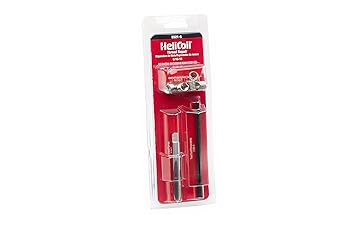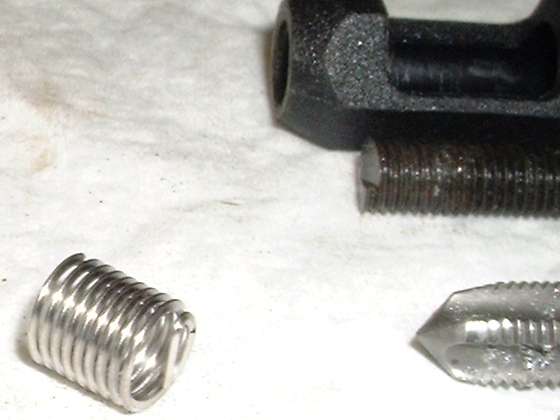How To Install A Helicoil In Aluminum
What do you do when you strip out threads in aluminum? You either drill and tap a larger bolt side (and use a larger bolt), or install an insert. One of the most popular varieties is called a Helicoil™, which looks a lot like a spring made of square wire. Helicoil Insert Basically you drill a larger hole, tap new threads, screw a. More How To Install A Helicoil In Aluminum videos. Need advice on Helicoil on the block. A Helicoil installed in aluminum will be about twice as strong as the original. DIY Heli-Coil install for headbolts. The aluminum alloys used on most of the sand cast components in a vehicle are typically in the 45-to-65 range in terms of hardness. Vega Fence Owners Manual. The highest hardness. Once the hole has been drilled, tapped and cleaned for the repair insert, the HeliCoil insert is screwed into place with the installation tool. Once the insert is located in.
Strippers can be expensive. Stop thinking rap stars, lap dances and sports celebrities. We are talking about a “stripper” in terms of a hole that has had its threads stripped out or damaged.


In addition to being expensive to repair, strippers also require a great deal of time and usually evoke a great deal of frustration. Fortunately, understanding the history of the materials being threaded along with the science of inserts can help you avoid encountering a stripper or, at least, be prepared to select the correct parts to repair a stripper. Done right, you’ll never have a thread failure in the same hole again. Text and Photos by Michael Ferrara // Illustrations by Paul Laguette Hard Times Forty years ago, the world was a harder place. Your grandparents weren’t lying to you. Cast-iron alloys and steels were the basic building blocks for just about anything.
On the automotive side, grey cast iron was the “go-to” material for engine blocks, cylinder heads, manifolds, housings and heavy brackets. Steel was the material of choice for smaller brackets, fasteners and the frame and body of the vehicle. While the mechanical properties (strength, stiffness, impact and corrosion resistance) varies immensely across different grey cast iron and steel alloys, they all have one thing in common.
For the most part, these materials, when used on components that have threaded holes, are all on the “hard” side with Brinell Hardness ratings (HB) in the 150 to 300 range (tool steels can get up to 900 on this scale). Being hard in nature, grey cast iron and steel will tend to have exceptional thread strength and thread retention capabilities as long as these materials are protected from corrosion. When thread damage does occur in cast iron and steel, the most common practice is to drill out the existing threads and tap the hole to accept a larger fastener. In many cases, this solves the problem. When the same size fastener must be used, an insert can be installed to save the day. Going Soft Today, it’s not just “emo” millennials that are softer. We live in a softer world.
The materials that have replaced grey cast iron and steel are relatively so. The world has moved from the Steel Age to the Aluminum Age. Pure aluminum will only hit 15 on the HB scale, whereas aluminum alloys can range in hardness from 20-to-150. The aluminum alloys used on most of the sand cast components in a vehicle are typically in the 45-to-65 range in terms of hardness. The highest hardness cast-aluminum alloys are used in block and cylinder heads. Torch Build Me Up Buttercup Torrent. These will typically have a range of hardness from 75-to-85, about the same as 6061-T6. Only 7075-T6 aluminum alloy has a hardness of 150 which is on par with grey cast iron.
Hard Bolt Meets Soft Threads While the materials where threads live have become softer, the materials used for fasteners have in many cases become harder. In fact, some of the super-alloys used in high-performance head studs and rod bolts have hardness levels approaching that of tap (every try to drill out a broken tap?). As a result, it’s no surprise that strippers are more common than ever before. Windev Mobile 17 Free Download here. Since most of the threads on today’s vehicles are made of materials with just one-third to one-half the hardness of grey cast iron, it’s no wonder that more threaded holes experience thread damage than ever before. It’s been said, “If a threaded hole in a softer metal uses a fastener that is installed and removed on a regular basis, a harder-material insert is a must.” Unfortunately, the cost and time involved with installing inserts at an OEM level means that it will never happen on a large scale. There may be a few key, high-stress locations in an engine block or suspension component, but 99 percent of all the threaded holes will not come from the factory reinforced with an insert. The Solution If every single aluminum component in the world could be manufactured from 7075-T6 aluminum alloy (which has equal hardness to typical grey cast iron alloys), the number of strippers in the world could be brought back down to the Steel Age numbers.